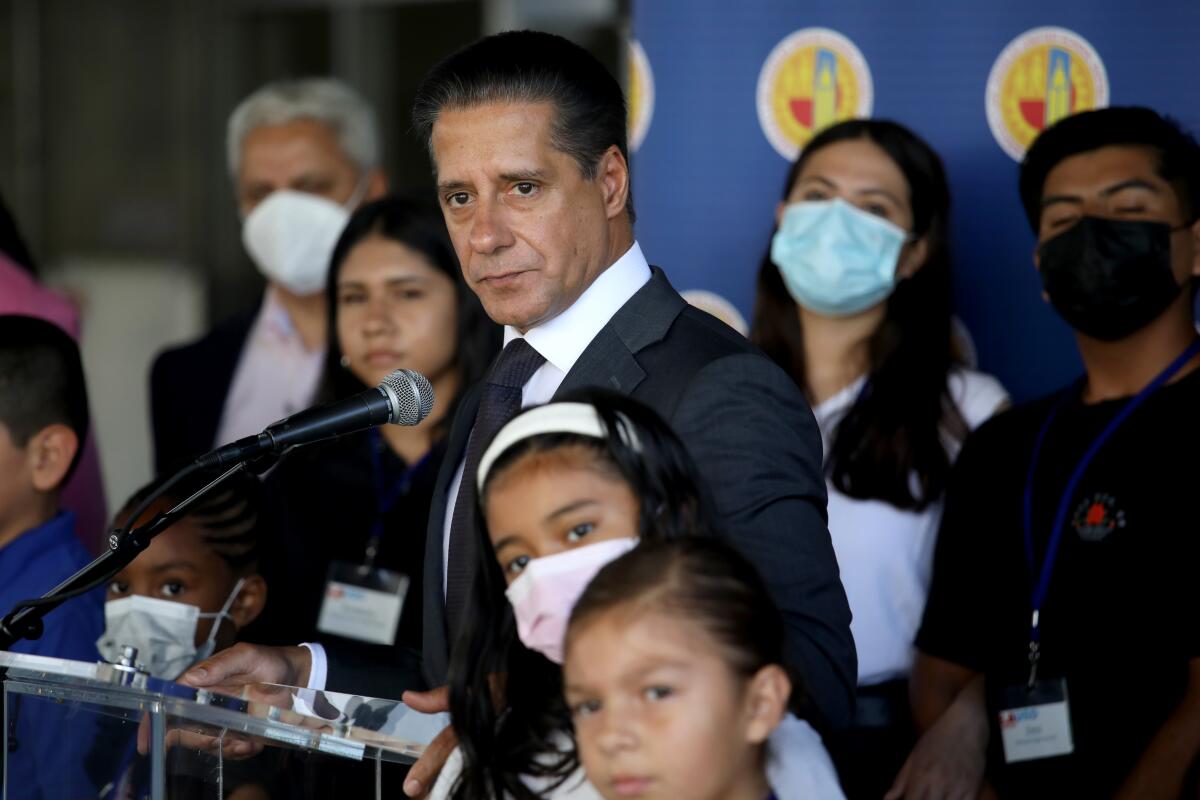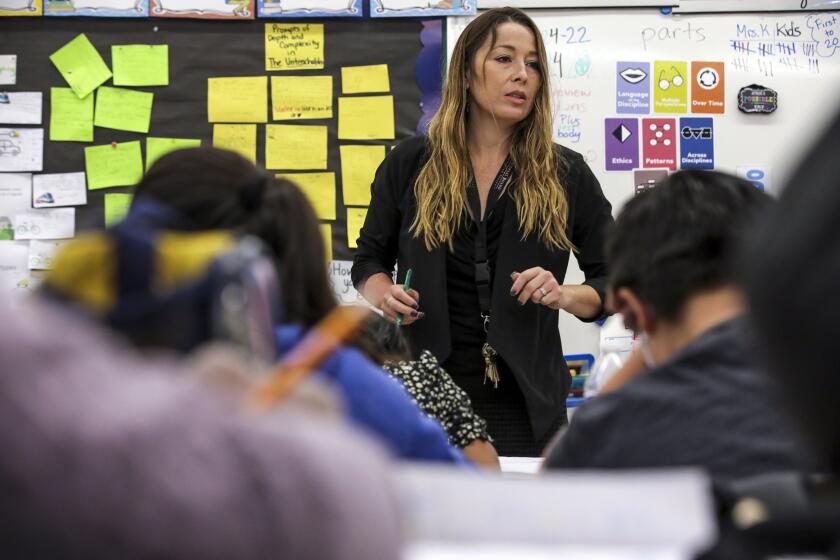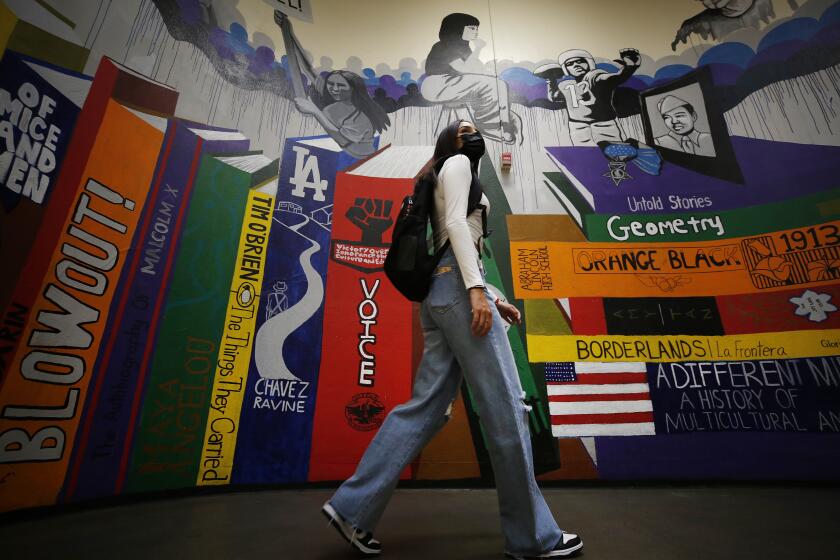L.A. Unified estimates tens of thousands of students are missing from back-to-school rosters

- Share via
Two weeks before school starts, Los Angeles Unified Supt. Alberto M. Carvalho estimates that between 10,000 and 20,000 students are not enrolled or stopped attending last year, with the problem most pronounced in the youngest grades.
As school officials work to identify and enroll the children, the district also is scrambling to fill about 900 classroom teaching positions and to find more than 200 bus drivers. Carvalho said Friday he is optimistic that most of the vacancies will be filled by the Aug. 15 start of school.
The superintendent’s estimate of missing students is based on outreach efforts by district staff to families and on assessments from outside groups.
Carvalho said he personally contacted or attempted to reach about 50 students who were chronically absent and their families in order to better understand the problem and asked 25 members of his senior staff to do the same.
Based on the discussions, he said there may be even more than 20,000 missing students, but numbers are hard to lock down. Several students in his outreach group told him of school-age siblings who were not in attendance at times last year.
“Some older, some very young. Some revealed that they themselves were caring for their younger siblings and that they themselves were working one, two jobs,” Carvalho said. “And they told me of many other kids who are in the same condition. That’s just not acceptable.”
Carvalho did not blame the students or their families, saying the district has to remove obstacles that are keeping students out of school, perhaps through more accessible transportation and better connection to counseling and other family services. Some families, he said, are choosing to keep children out of school or enrolling them elsewhere. He said the district must show that it offers high-quality programs, classrooms that are reasonably safe during the pandemic and campuses that are secure.
In the pandemic’s latest hit on education, the number of L.A. Unified students who have been chronically absent this school year has doubled.
The district is also confronting a worsening daily attendance problem. Data in March 2022 showed that nearly half of LAUSD students — more than 200,000 children — were chronically absent during the last school year.
Much of the absenteeism was related to COVID-19 quarantines and infections. In the coming year, there will be no at-home quarantines for close contacts without symptoms, although students and staff will have to remain masked during the quarantine period. And officials are hopeful that the number of outbreaks will be low.
But even without including those required to stay home because of pandemic restrictions, the chronic absentee rate was about 20%, Carvahlo said, calling the figure “exceedingly high.”
The district’s K-12 enrollment, which was about 430,000 last year, has been on a marked decline and is projected to plunge by nearly 30% over the next decade.
One big change from last year will be a relaxation of COVID-related rules. The district will no longer require students and staff to be tested for the coronavirus on a weekly basis, and there will be no baseline testing prior to the start of school.
LAUSD has had among the most costly and rigorous coronavirus testing polices in the nation, a mammoth operation of about half a million tests a week that was the single largest source of coronavirus testing in L.A. County during the last school year.
In addition, the district will no longer require its daily health check, which parents or students had to show on their cell phones or on printouts as they entered campus. Under this Daily Pass system, students had to be up to date on COVID-19 tests and attest to their good health.
Instead, parents and students will report only positive test results or when children are sick. As much as he wants to improve attendance, Carvalho said, no one should put it ahead of staying home when ill. He added that the district has as many quick-read antigen tests as needed.
As the district gears up to open classrooms, many of the difficult issues of the 2021-22 school year persist when it comes to staffing, including the hiring of qualified teachers amid an ongoing state and nationwide shortage and the dire need for intense academic recovery. Although spring standardized tests scores have not yet been released, a preliminary look at the data shows cause for deep concern, Carvalho said.
“Soon our academic data will be released, and I know what it will show,” he said. “It will show significant loss, significant regression. Now is the time for us to accelerate, and we will be ready to teach on day one.”
A Los Angeles Times analysis of data offers an alarming assessment of the impact of the pandemic on L.A. students.
Carvalho said the current figure of 900 classroom teacher vacancies is not far off historical averages, and he will deploy qualified out-of-classroom staff to campus to the extent needed.
“We continue to hire every single day,” Carvalho added. “If you have what it takes — if you are a credentialed individual.”
The teacher shortage last year hit the district’s highest-needs campuses the hardest. Carvahlo first tried the redeployment strategy last spring.
In addition, the district is short about 200 bus drivers out of a workforce of 1,000. The figures don’t include 400 drivers a new private contractor hopes to bring on with a $5,000 hiring bonus. For its part, the district is phasing in a plan to pay drivers for an eight-hour day rather than a six-hour day, a 33% increase.
Busing supervisors and trainers will fill in as needed. In the worst case, the number of stops could be reduced or routes consolidated, leading to longer bus rides and wait times for students.
The school district provides transportation to about 12% of students — mainly those with disabilities, those who attend magnet schools and those who need it to attend special events, such as for athletics or field trips. The official “walking distance” for an L.A. school is five miles — too far, Carvalho says. His goals have included offering more busing to provide access to more educational options.
One feature unveiled Friday could make those long bus rides seem shorter. The district, using grant money, has equipped all its buses with WiFi. It also has a new starter fleet of 11 electric buses.
Wilson High School 12th-grader Brianna Castaneda was among those invited to see the new buses Friday. To get to her Eastside magnet school, she has to travel two miles to the pickup point at Locke High in Watts by 6:15 a.m. Sometimes she is not dropped off back at the Locke High stop until after 5:30 p.m.
Brianna was grateful for the WiFi upgrade.
“It was a good idea, because there’s only so much you can do with your phone,” she said. “Let’s say I have slides to do for school. Now I’ll be able to use my laptop on the bus, so I think that’s cool.”
More to Read
Sign up for Essential California
The most important California stories and recommendations in your inbox every morning.
You may occasionally receive promotional content from the Los Angeles Times.
















